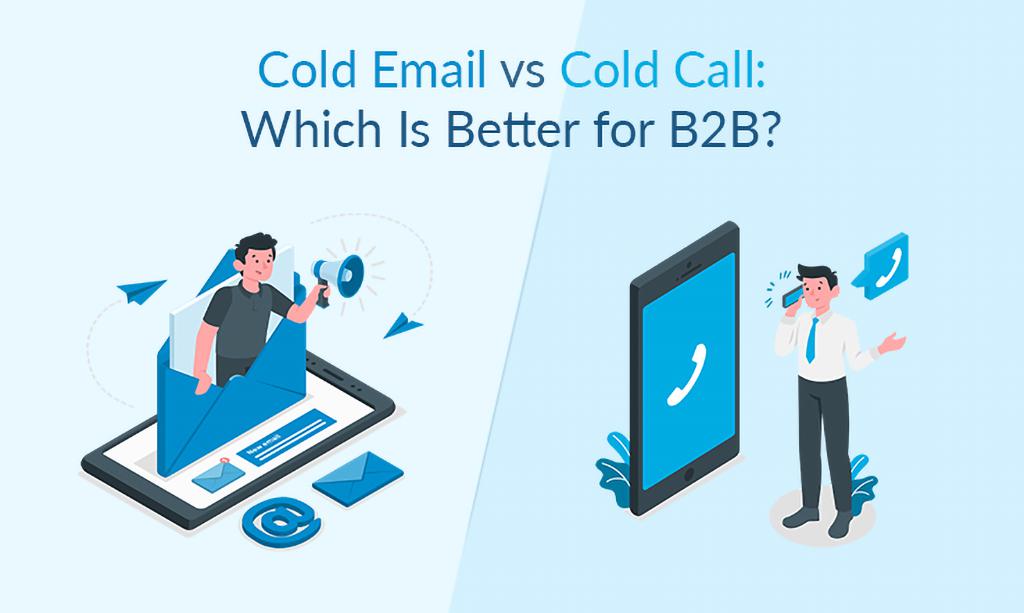
When it comes to prospecting, it is important to choose the right strategy to pitch your business. There’s a never-ending debate on which method works best: cold email or cold call. Should you go all-in on cold email, prospecting, or explore cold calling?
In this article, we’ll discuss in detail the key differences between these two strategies and learn about their performance based on real data.
Cold Email Vs Cold Call: The Difference Between Each Strategy
By simply looking at the terminologies, you can probably tell the major difference between cold emails and cold calls. The first one requires sending an email while the second involves making calls but both target people who aren’t currently engaging with you to buy your product or service. Let’s dig deeper and try to understand the fundamental differences.

Cold Emails are less intrusive.
No one likes their privacy to be invaded. This is the reason why emails are a safer option than calls when it comes to prospecting. Calling a prospect out of the blue may mean disturbance and that could harm your business in terms of brand perception.
Would you be happy if you received an anonymous sales call in the middle of an important meeting? Probably not.
Calls create a more personalized experience.
Between reading an email and having a conversation over the phone, the latter is more engaging and can better develop mutual trust and respect.
It’s no secret that building rapport and having a personal conversation with a prospect are essential drivers in achieving the primary goals of prospecting — brand awareness and encouraging further contact.
Email is easier and much cheaper.
One of the goals of prospecting is to try to reach as many people as you can in a short period. You can do that with cold emailing while with cold calling, you can only speak to one prospect at a time.
Sending prospecting emails is a cost-effective and powerful way to reach out to your prospects. The cheaper operational expenses and its promising return on investment make it a top choice for most businesses.
Cold emails are also easier to distribute and track. The entire distribution and tracking process can be automated which saves you time and money.
However, injecting call as a medium in your sales process also has powerful benefits. Prospects are most likely to schedule a meeting or be more interested in purchasing whenever they get to speak with a salesperson in their first contact.

Key Statistics to Know
- 82% of buyers say they have accepted meetings with salespeople after a series of contacts beginning with cold sales calls.
- An average B2B company spends $10,000-$15,000 hiring a sales representative and only $2,000 a year providing that individual with sales training.
- Segmented, targeted, and personalized emails generate 58% of all revenue.
- Email generates $42 for every $1 spent, which is a 4,200% increase in ROI.
- Typical response rate for email is 1%, which means for every 100 sends, you’ll get through one person.
- Tuesday is the best day of the week to send an email with Thursday coming in second.
- By addressing the recipient by their name, you can increase open rates and CTR up to 35%.
- 80% of buyers prefer to receive emails from sellers than calls.
- 31% of companies say that a well-researched and custom email is very effective when engaging with prospects.
- Wednesdays and Thursdays are the best days to call a prospect.
Cold Email Vs Cold Call: When to Use Which?
Now, the question is, should you send an email or dial that number for a call?
Every business is unique, each has its own goals and strategies. But when determining whether to call a prospect or send an email, these guiding factors might help.
1. Know The Purpose of Your Outreach
Identify the reason why you want to reach out to a prospect. Is it to acquire additional personal information? Schedule a meeting? Or conduct a survey?
Understanding the purpose of your first outreach helps you easily determine whether you should dial a number or compose an email. It is recommended to call for asks that require more obligation from the prospect. For example, if you want to schedule a meeting, this requires a “yes” from your prospect which means your salesperson needs to do more than just sending an invitation email.
For simple requests that you need from a prospect, go ahead and send an email, wait for a response, and follow up if necessary. Avoid calling for a simple question as it may seem invasive and a waste of their time.
Take note that the strongest asks — building a connection and completing a transaction — should be made over the phone at the start and conclusion of each sales interaction. Reps should use email as a rule of thumb in the interim.
2. Know Your Target Audience and Their Preferences
May it be in marketing or sales, it is important to truly know your target audience to the core. Describing your target audience will make it easy for you to choose between cold email or cold call.
If you are aiming to connect with C-level executives, ringing them might not be as effective as sending an email on your first outreach. Remember, these professionals are extremely busy and very particular about their schedules.
Research suggests that younger professionals and customer-facing roles prefer to receive a phone call than an email. This is worth remembering when finalizing your strategy.
In a nutshell, people like to communicate in a different way than others. Their preferences are influenced by a variety of variables, including their age, the nature of their employment, the industry they are in, and so on.
3. Understand the Best Time for Each Channel
Picking the right time and day is crucial when doing prospecting. In prospecting, it’s usually the salesperson who will initiate the reach out. This makes the first outreach reliant to the salesperson’s schedule.
Let’s assume you are the one planning to connect with a prospect at 6:00 PM in your local time zone. Do you think your prospect will pick up your call? Or do you think it is better to send an email instead?
Be careful in choosing your approach depending on the time and day of your initial reach out as this will heavily affect the success of your engagement.

Final Thoughts
There’s no right or wrong answer when asked which method you should adopt for your business. Both cold email and cold call outreaches are effective if performed correctly. A great number of companies reported that integrating cold email and cold call campaigns are deemed to be most effective in the B2B industry.
Try implementing these tactics and don’t be afraid to do experimental campaigns. Use the trial-and-error method where you retain strategies that are proven effective and improve those that do not perform well. Only then will you determine what works best for you and what does not.
Need help with your cold email campaigns? MailClickConvert is a powerful platform that allows businesses to send emails to a purchased cold contact list. MailClickConvert boasts its capability of converting cold contacts into real sales leads.
- Log in to post comments

